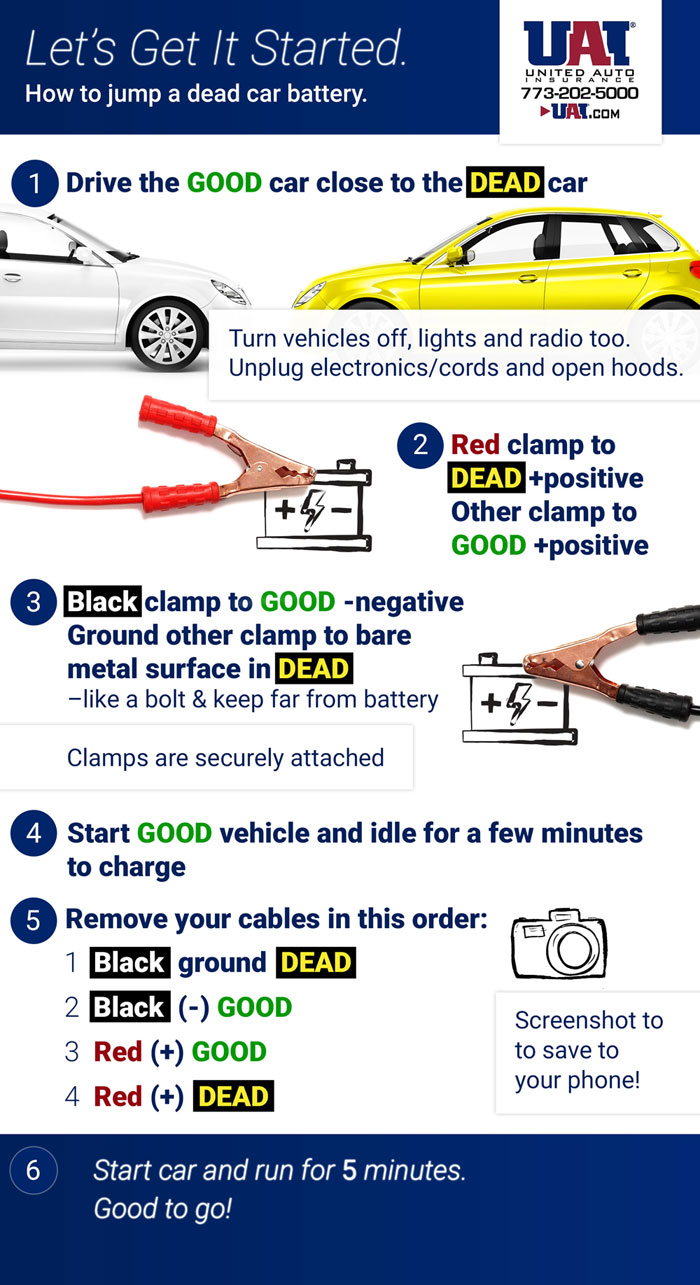
A dead battery can turn a normal day into a stressful one, especially if you are in a rush or stranded. Knowing how to jump start a car is an essential skill every driver should have. This guide from United Auto Insurance explains how to jump a car safely, what tools you need, and the exact jumper cable order to follow to protect yourself and your vehicle.
What You Need to Jump Start Your Car
To properly jump start your car, make sure you have the following:
- A set of jumper cables
- A second vehicle with a working battery that matches your battery's voltage
- A safe location away from traffic
Step-by-Step Instructions to Jump Start a Car
Knowing how to safely jump start a vehicle is just as important as having the right tools. Incorrectly connecting jumper cables can result in electrical damage or personal injury. The following jump start car procedure outlines the exact steps to jump a car and should be followed in the correct sequence to avoid damage.
- Park both vehicles and turn off the ignition. Engage the parking brakes on both cars.
- Open both hoods and locate the batteries. Remove any covers if needed.
- Attach the red cable to the positive terminal of the dead battery.
- Attach the other end of the red cable to the positive terminal on the working battery.
- Attach the black cable to the negative terminal of the working battery.
- Attach the other end of the black cable to an unpainted metal surface on the car with the dead battery.
- Start the working car and let it run for a few minutes.
- Start your car. If it doesn’t start immediately, wait a bit longer and try again.
- Once your car starts, let it run for at least 15 minutes to help recharge the battery.
Jumper Cable Removal Sequence
Once your car is running, it is important to remove the jumper cables in the correct order to prevent sparks or short electrical circuits. The disconnection process should be done carefully, following the reverse of the connection steps to ensure safety.
Remove the jumper cables in this order:
- Remove the black cable from the unpainted metal surface
- Remove the black cable from the negative terminal on the working car
- Remove the red cable from the working car’s battery
- Remove the red cable from your car’s battery
What If Your Car Battery Dies Again
After jumpstarting your car, the battery should hold a charge if the issue was temporary. If it dies again, the battery may need to be replaced, or there may be another issue.
Call a roadside assistance provider or visit your local mechanic for a battery test.
Frequently Asked Questions About Jump Starting a Car
Have questions about the right way to jump start a car? Here are clear answers to the most common concerns drivers have.
How do I jump start my car?
Follow the above steps and use the correct jumper cable to avoid injury or damage
What is the correct jump start cable order?
Positive to positive, then negative to metal. Disconnect in reverse order.
Can I jump start a completely dead battery?
Yes, if the battery is not damaged. If it does not hold a charge, it likely needs replacement.
Is it safe to jump a car in the rain?
Yes, if you are cautious, avoid letting cables touch or contact wet parts.
How long should I let my car run after a jump start?
Let the car run for at least 15 minutes or drive for 20 to 30 minutes to allow the alternator to recharge the battery.
Have Questions About Your Auto Insurance Coverage?
If you have more questions about getting coverage or want to learn how roadside assistance fits into your auto insurance plan, our team is here to help. United Auto Insurance offers cheap auto insurance rates, instant quotes, and reliable protection for drivers across Chicago, Illinois, and Indiana.